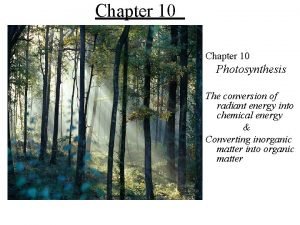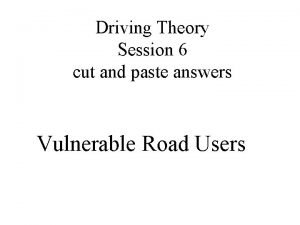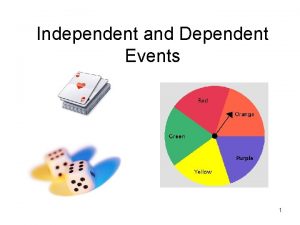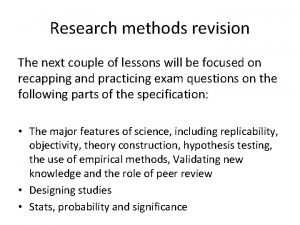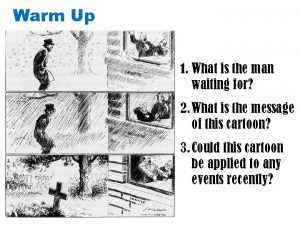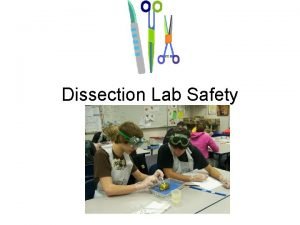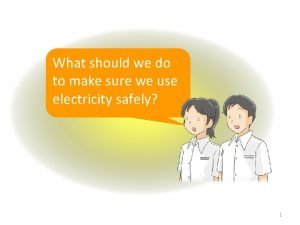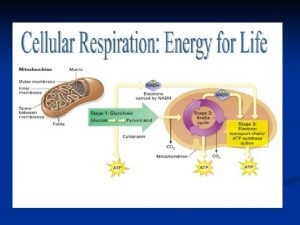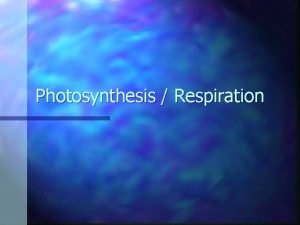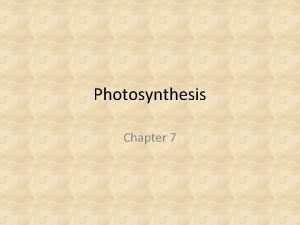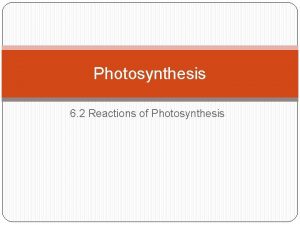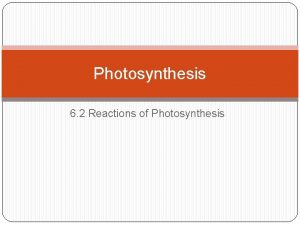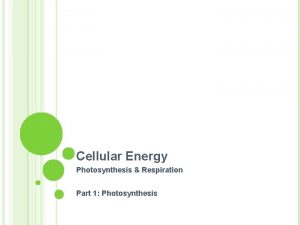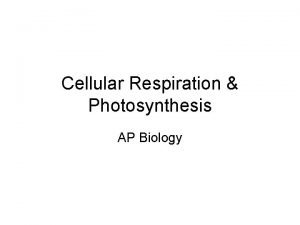Photosynthesis Why you should care I Major event









































- Slides: 41

Photosynthesis: Why you should care I. Major event in history of life on earth Without it, no aerobic respiring organisms (you) II. Uses a renewable energy source to feed life on earth III. Good for the air you breathe IV. Primary producer of food!

West Virginia Indonesia

WHEN?

Photosynthesis: When did this all start? Photosynthesizing bacteria were not the 1 st bacteria Earth forms - 4. 6 bya First life - 3. 8 bya Photosynthesis - 2. 7 bya

WHO?

not just plants Cyanobacteria (Bacteria) Diatoms (Protista) Green Algae (Protista)

Photosynthesis evolved in bacteria archaea eurkarya photosynthesis Aerobic cell respiration photosynthesis Common ancestor: glycolysis and fermentation

The major players + 6 CO 2 +6 H 2 O 6 O 2 + sugar • Notice: matter on left = matter on right • Not easy as that • Need VERY important ingredient…


Pigments Location: Thylakoid membrane Job: absorb light at a specific wavelength (structure/function) Types: Chlorophyll (many sub-types), Carotenoids Looking at the energy, what wavelength would you predict chlorophyll absorbs? (write answer in notes).

Chlorophyll: Absorbs Blue/Red Light Did you predict the red? Fig 10. 6

Reason for red and blue absorption (but no green):

The molecules that absorb only certain wavelengths of light energy from the Sun in order to begin the photosynthetic reactions are called _____. A. B. C. D. chloroplasts oxygen stroma pigments

Cyanobacteria Formerly called “blue-green algae” The first organisms to introduce oxygen in primitive atmosphere Live in fresh water, soil, moist surfaces, other organisms (ferns, fungi) In some areas, a health problem- produce toxins (i. e. in ponds and lakes used for swimming) Cyanobactieral blooms (CDC: “HABs”)

Photosynthesis: Big Picture + CO 2 + H 2 O O 2 + sugar Conversion of electromagnetic radiation in sunlight to chemical energy in C-C and C-H bonds of sugar The C, H and O atoms in sugar come from CO 2 and H 2 O (relatively oxidized). To convert C, H and O to high energy sugar (relatively reduced), need energy from sun.


HOW?

Photosynthesis: Big Picture + CO 2 + H 2 O O 2 + sugar Two Phases Light-dependent reactions Calvin cycle reactions I. Light strikes and excites electrons in chlorophyll ATP and NADH used to make C-C bonds reducing CO 2 to sugar II. Energy from excited epasses down electron transport chain producing ATP and NADHP III. In the process, H 2 O oxidized to O 2

Light-dependent Reactions This is a two part process: occurring in 2 different photosystems -arrangements of chlorophyll and other pigments packed into thylakoid membranes -both absorb light which triggers electron excitation and electron transport chain -products are different Photosystem II: makes ATP (discovered 2 nd) Photosystem I: makes NADPH (discovered 1 st)

Possible outcomes of electron excitation: 1. fluorescence

Chlorophyll molecules arranged in clusters (photosystems) which are embedded in the thylakoid membranes Fate of excited electrons: 2 - resonance Fate of excited electrons: 3 – Red/oxid

So, how does a photosystem work?

What is the significance of PQ?

Light-dependent Reactions As the electron (energy) is passed from one molecule to another in the electron transport chain, released energy is used to make ATP and NADPH ETC high e- energy of electron low energy released in form of ATP and NADPH e- chlorophyll To replace the electron, H 2 O donates an electron resulting in “splitting of water” to H 2 and O 2

PSII: ETC in Photosynthesis is similar to ETC in cell respiration: gradual step-down of re-dox reactions from high to low energy. There is a series of molecules embedded in thylakoid membrane. as they give up electrons they just received, they give off energy b/c they are becoming oxidized to lower energy state. PSII Outcome * H 2 O split to O 2 * ATP generated Fig 10. 15

PSI: again, light shines on chlorophyll and excites electron, which now is replaced by electron from PSII. Result of ETC is NADPH (electron carrier) Last slide (PSII- generates ATP) (PSI- generates NADPH)

Both photosystem I and photosystem II employ the use of a(n) _____, which drives the formation of ATP and NADPH. A. B. C. D. calvin cycle ferredoxin shuttling chain citric acid cycle electron transport chain

Which statement is most accurate concerning how photosystem II (PS II) compares to the electron transport chain (ETC) of mitochondria? • In both systems, high-energy electrons come from NADH. • In both systems, ATP is produced by chemiosmosis. • PS II produces ATP by chemiosmosis; the ETC of mitochondria produces ATP by substrate-level phosphorylation. • The ETC associated with PS II shares no similar components with the ETC of mitochondria.

http: //www. netplanet. org/business/videos/view. php? video=e. Y 1 Reqi. Yw. Ys&feature=youtube_gdata&t itle=Light+(Dependant)+Reactions++of+Photosynthesis+Animation

Summarize photosystems 1 and 2 with a figure. • Take 5 minutes to draw (from memory) a cartoon/schematic of what happens in both photosystems and the relationship between the photosystems. Include labels and relative energy amounts. • Make a bulleted list of the overall process of the light reactions – – What is added? what happens to water? …O 2? what is produced?

Summary of Photosystem II and I = The Light Reactions • uses light energy • H 2 O is split • O 2 is released • produces ATP • produces NADPH But still need to use CO 2 and make sugar!!! + CO 2 + H 2 O O 2 + sugar

The light reactions of photosynthesis A. Produce ATP and Sugar B. Produce ATP and NADPH C. Use ATP to excite an electron in chlorophyll D. Produce oxygen when water donates it’s electron to Photosystem II E. B and D.

Calvin Cycle CO 2 from the atmosphere enters organism CO 2 reduced to organic C = sugar (carbon fixation) This is a reduction reaction; requires energy Energy NOT from sunlight, but from ATP and NADPH of light-dependent reactions Melvin Calvin, Nobel Prize 1961


Calvin Cycle Carbon From LIGHT rxn 3 C sugars From LIGHT rxn Outside of thylakoids *Rubisco (enzyme that catalyzes addition of CO 2 to Ru. BP) is the most abundant protein on earth

• Which answer best explains why it is accurate to call the Calvin cycle a "cycle"? 1. It uses ATP produced by cyclic photophosphorylation. 2. The NADPH and ATP it uses are recycled by the cell. 3. Calvin cycle enzymes exist as a cycle-shaped complex inside thylakoid membranes. 4. It regenerates a substrate of the first reaction.

For the Calvin Cycle… • write the equation for the Fixation phase. • …. Reduction phase. (include the amounts of G 3 P and where they go) • …Regeneration phase.

If Calvin Cycle doesn’t require light directly, can it occur at night?

Another important note about photoautotrophs Recall: Ultimate energy source is sun Carbon source is CO 2 While YES, the C in CO 2 is converted to the C molecules in sugar, that C is needed for other molecules as well Any C-containing molecules the plant makes is going to contain C that originally came from CO 2 o o C Cellulose (cell wall)

During photosynthesis A. Conversion of CO 2 to sugar requires energy which comes directly from the sun B. Conversion of CO 2 to sugar requires energy which comes from ATP and NADPH C. All Carbon from CO 2 that enters the organism will be converted to sugar D. Oxygen and Sugar are both products of the light reactions

Photosynthesis Cell Respiration sunlight PSII ETC O 2 PSI electron transport chain Krebs Cycle Calvin Cycle ATP glucose acetyl Co-A
 Hey hey bye bye
Hey hey bye bye Why do you cry, willie
Why do you cry, willie Primary secondary tertiary health care
Primary secondary tertiary health care Two major steps of photosynthesis
Two major steps of photosynthesis You should always seek professional medical care for
You should always seek professional medical care for Injured motorcyclist lying unconscious
Injured motorcyclist lying unconscious What does sentinel event mean
What does sentinel event mean Simple event and compound event
Simple event and compound event Independent or dependent
Independent or dependent Dependent events examples
Dependent events examples 5 ws of event management
5 ws of event management Bridge breaks in central java the text tells us about
Bridge breaks in central java the text tells us about Newsworthy event (s) background event (s) sources
Newsworthy event (s) background event (s) sources Don't ask why why why
Don't ask why why why If you are being passed you should
If you are being passed you should The space between traffic clusters is called a
The space between traffic clusters is called a Chapter 24 facial makeup
Chapter 24 facial makeup Why is photosynthesis important
Why is photosynthesis important The more you care the stronger you can be
The more you care the stronger you can be If i could only teach you one thing why god made you
If i could only teach you one thing why god made you If you could be invisible what would you do and why?
If you could be invisible what would you do and why? Why is theory construction a major feature of science
Why is theory construction a major feature of science Why does the sergeant major say, “better let it burn”?
Why does the sergeant major say, “better let it burn”? Why should i feel discouraged
Why should i feel discouraged Ayron lewis
Ayron lewis Most fad diets do follow the mypyramid guidelines
Most fad diets do follow the mypyramid guidelines Why football players should wrestle
Why football players should wrestle Why all businesses should embrace sustainability
Why all businesses should embrace sustainability Why christians should not celebrate halloween
Why christians should not celebrate halloween Rarig's kid doesn't starve why should we
Rarig's kid doesn't starve why should we The lord is my light my joy and my song
The lord is my light my joy and my song What is community problems
What is community problems Ekimme
Ekimme Importance of eiffel tower
Importance of eiffel tower Why we celebrate columbus day
Why we celebrate columbus day We should not touch electric switches with wet hands. why
We should not touch electric switches with wet hands. why You say you love the rain but you open your umbrella
You say you love the rain but you open your umbrella Agree or disagree questions about life
Agree or disagree questions about life If you think you can you can poem
If you think you can you can poem Tell me what you eat and i shall tell you what you are
Tell me what you eat and i shall tell you what you are Whereever you go i will follow
Whereever you go i will follow Care certificate standard 3
Care certificate standard 3



